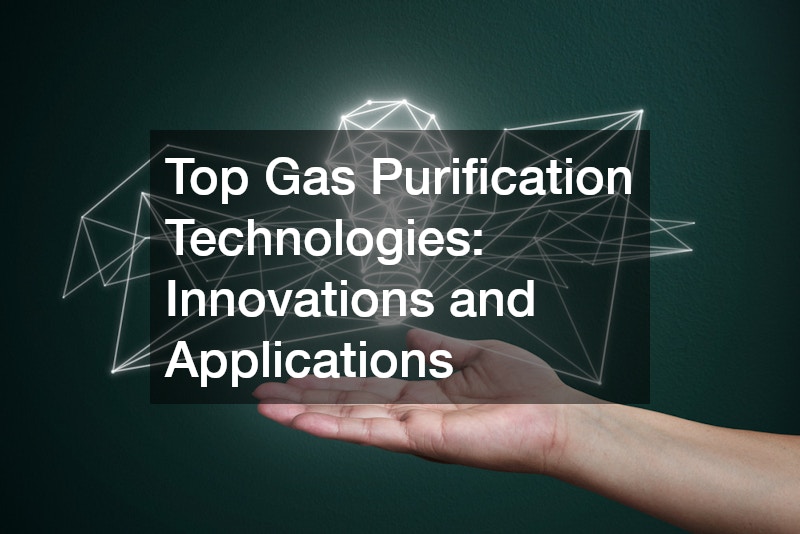
Gas purification is a critical process across numerous industries, ensuring the removal of impurities to produce high-quality gases for manufacturing, healthcare, and environmental applications. As industries face stricter regulations and the demand for cleaner processes grows, understanding and implementing the top gas purification technologies is more important than ever. By adopting top gas purification technologies, companies can improve operational efficiency, reduce environmental impact, and enhance workplace safety.
Latest Advancements in Gas Purification
Membrane Technology Innovations
Membrane-based gas separation has advanced considerably, providing high selectivity and permeability while consuming less energy than traditional methods. Recent developments in polymeric membranes, mixed-matrix membranes, and hollow fiber designs allow precise separation of gases like hydrogen, nitrogen, and carbon dioxide. These improvements make membrane technology an attractive choice for industries that require scalable, energy-efficient purification systems.
Adsorption Techniques
Adsorption remains one of the most versatile gas purification methods. Modern adsorbents such as metal-organic frameworks (MOFs) and zeolites offer high surface areas and tunable pore structures, making them effective at capturing specific contaminants like CO2, H2S, and moisture. These materials can be applied in both large-scale industrial operations and smaller, specialized systems, providing flexibility for diverse purification requirements.
Cryogenic Distillation Updates
Cryogenic distillation continues to play a vital role in producing ultra-pure gases such as oxygen, nitrogen, and argon. Recent technological refinements, including optimized column design, advanced heat exchangers, and better process control, have enhanced purity levels and reduced energy consumption. These improvements make large-scale gas separation more practical and cost-effective, particularly in industries that demand consistent, high-quality gas supplies.
Scrubbing Technologies
Scrubbing methods have evolved to address environmental and operational challenges. Chemical scrubbing uses reactive agents to neutralize acid gases, while biological scrubbing employs microbes to degrade pollutants. These techniques are highly effective in controlling emissions of CO2, H2S, and other harmful gases, helping industries comply with environmental regulations while minimizing their ecological footprint.
Impact on Industrial Applications
Industrial Gas Production
Advances in gas purification technologies allow for cost-effective and efficient production of industrial gases. Sectors such as steel manufacturing, healthcare, and food processing rely on these technologies to maintain product quality, reduce waste, and meet high operational standards.
Environmental Mitigation
Modern purification systems significantly reduce environmental impact by capturing harmful gases before they are released into the atmosphere. This helps lower greenhouse gas emissions, improve air quality, and support corporate sustainability initiatives, aligning with both regulatory and societal expectations.
Energy Efficiency and Safety
Efficient purification systems save energy by optimizing separation processes, lowering operational costs, and reducing carbon footprints. Removing contaminants also prevents equipment corrosion, operational failures, and safety hazards, promoting safer workplaces and more reliable industrial operations.
Industries Benefiting Most
Oil and Gas
Purification technologies are essential for natural gas processing, refining, and emission control, ensuring compliance with environmental regulations and producing high-quality products for downstream applications.
Chemical Manufacturing
Chemical plants require purified gases for raw material preparation, reactions, and emission management. Advanced gas purification ensures product consistency, improves process efficiency, and supports sustainable operations.
Pharmaceuticals and Healthcare
Ultra-pure gases are crucial in pharmaceuticals and medical applications, including drug manufacturing, laboratory use, and sterilization. Reliable purification technologies are necessary to meet strict quality and safety standards.
Aerospace and Automotive
High-purity gases are used in aerospace and automotive manufacturing for welding, testing, and propulsion systems. Purification ensures operational precision, safety, and product longevity, supporting the rigorous standards of these industries.
Future Trends
AI Integration
Artificial intelligence is increasingly being integrated into purification systems to optimize performance, enable predictive maintenance, and reduce operational downtime, enhancing overall efficiency.
Eco-friendly Materials
Research is focused on developing sustainable materials for gas purification, reducing environmental impact while maintaining high performance and reliability.
Hybrid Purification Systems
Combining multiple technologies, such as membranes with adsorption or scrubbing, improves overall purification efficiency and allows systems to meet specific industrial requirements more effectively.
Cost Reduction
Innovations continue to lower both capital and operational costs, making advanced purification technologies accessible to a wider range of industries and encouraging broader adoption of cleaner processes.
The field of gas purification is evolving rapidly. The top gas purification technologies—including advanced membranes, adsorption materials, cryogenic distillation, and scrubbing methods—provide versatile solutions for industries seeking efficiency, safety, and environmental compliance. By adopting these technologies, businesses can achieve high-quality production, minimize emissions, reduce energy consumption, and maintain sustainable operations. Staying informed about emerging trends ensures that industries remain competitive while contributing to cleaner and safer industrial practices.

